1965 German Grand Prix race report: Clark king at the 'ring
Jim Clark crowned champion after taking his sixth win in a row; BRM's Graham Hill and Brabham's Dan Gurney fill out the podium positions
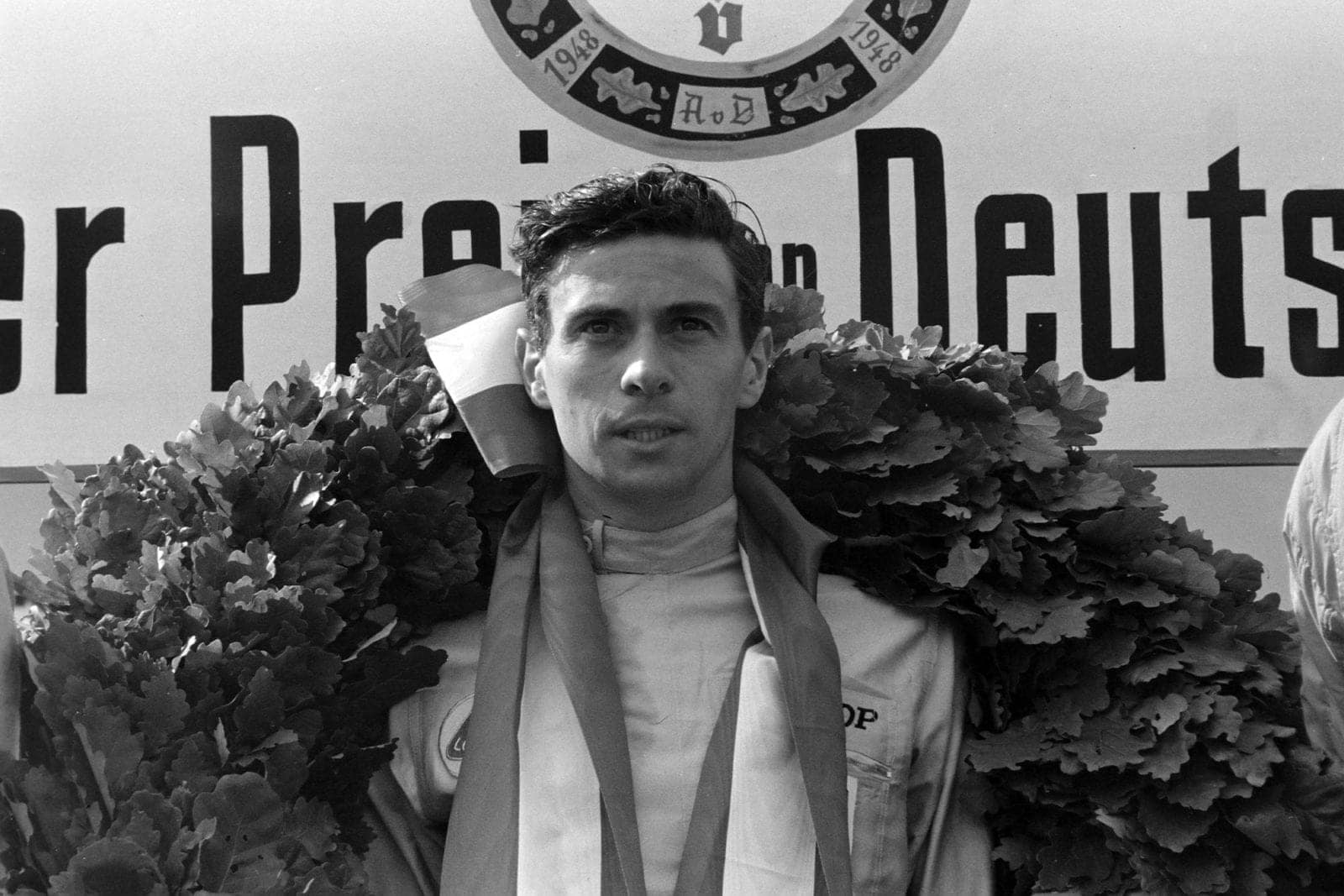
Lotus' Jim Clark stands on the podium after winning his sixth race of the season
Motorsport Images
The Automobil Club von Deutschland organised the German Grand Prix on the hilly and tortuous 22.81-kilometre Nürburgring in the Eifel mountains and at the last moment they reduced the number of practice sessions from four to three, although two of the sessions were of two hours duration and the third was for one and a half hours. The difficulty at the Nürburgring is that if a car breaks down out on the circuit it is more than likely to be on an inaccessible part, only arrived at by going round the circuit with a transporter, and one or two drivers missed a whole practice session because of this.
The entry list was a very complete one including nearly everyone who normally competes in Formula One races, the Nürburgring being long enough to accommodate 23 cars with ease. Both Lotus and Brabham fielded “three-car” teams, all six cars using Coventry-Climax V8 engines, but only Clark had the latest 32-valve unit, the Brabham 32-valve engine still not being repaired after its Silverstone disaster. Clark’s car was R11, and Spence had R9, with a shortstroke flat-crank engine, and the German driver Gerhard Mitter had old R6, with a long-stroke engine. All three cars were to Lotus 33 specification as regards 13in wheels, knock-off hubs, steering and suspension.
The three Brabhams of Jack Brabham himself, Gurney and Hulme were all using 90 crankshaft Climax engines, with cross-over high-level exhaust systems. Ferrari entered Surtees and Bandini, the World Champion having the original flat-12-cylinder car, chassis number 0007, and also a brand new one to the same specification with a similar 12-cylinder engine, this being chassis number 0008. Bandini had a V8 Ferrari, chassis 0006, the second of the 8-cylinder cars.
The BRM team of Graham Hill and Stewart had the same three cars as at Zandvoort, the 1965 cars to race and the 1964/65 car as a practice car for Hill, while McLaren and Rindt had three works Cooper-Climax V8 cars, the spare one having the Hewland gearbox. The Honda team should have completed the list of factory entries, but they decided to give the Nürburgring a miss and the whole racing team returned to Japan to sort out various problems and prepare for a really serious attack at Monza on September 12th.
The regular private teams were all in attendance, Bonnier and Siffert with RRC Walker’s cars, Amon and Attwood with Parnell’s cars, Anderson and Hawkins entered by DW Racing Enterprises, Frank Gardner with the Willment Brabham-BRM V8 and Masten Gregory and Roberto Businello with the CentroSud BRMs, the latter replacing Lucien Bianchi at the last moment. The final entry was Raby’s Brabham-BRM V8 which should have been driven by Amon but as Ireland could not be present, Amon moved into the Parnell team and Raby drove his own car.
Qualifying
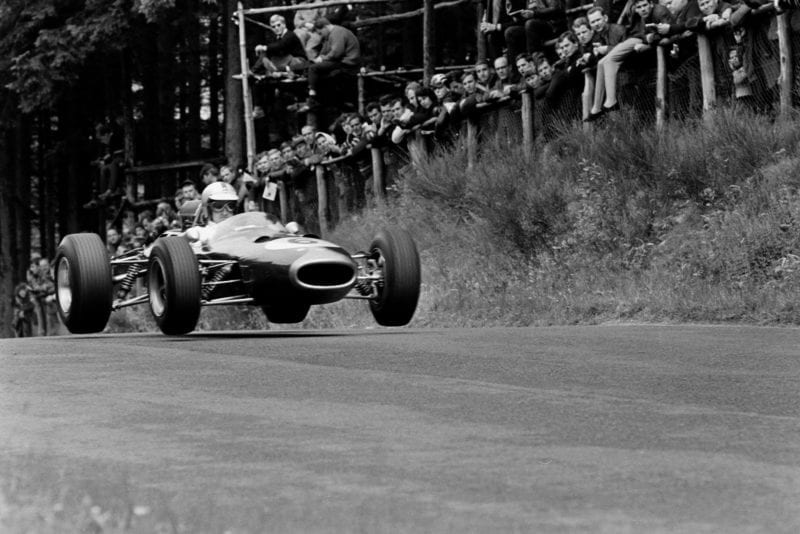
Hulme jumped into (and took off) a third works Brabham
Motorsport Images
For the practice on Friday morning Lotus only ran Clark and Spence, but neither of them went very fast as the cars were grounding in some of the dips and had to be taken away for modifications. Surtees only used the first of the 12-cylinder Ferraris, the new car being left in the paddock, but everyone else was circulating. Since last year, when Surtees recorded 8min 38.4 sec. in practice and 8min 39.0sec in the race, a long section of the circuit has been smoothed out and resurfaced, and with the improvements in road-holding and power units it was no surprise that the existing record lap time was soon improved upon.
The surprise was that it was Stewart who improved upon it the most, with the BRM, leading Surtees, Hill and Gurney, all of whom beat the existing lap record. Siffert and Bonnier both went very quickly in this first practice, but Raby had trouble on his first lap and was stuck out on the circuit until lunch time, while Attwood bent the rear suspension of his Parnell Lotus-BRM and was also unretrievable.
“There was much talk and speculation during the lunch break over Stewart lapping nearly nine seconds quicker than the existing record”
There was much talk and speculation during the lunch break over Stewart making fastest practice time and lapping nearly nine seconds quicker than the existing lap record, for while it was anticipated that times would improve it was not expected that such a big improvement would be made.
The phenomenon that is Jackie Stewart had not been reckoned with, many people felt. However, during the afternoon session of practice a sense of proportion was brought to the meeting by Jim Clark, for having got the Lotus 33 set up properly he went out and had a bit of a go to put in a fast lap. The 1964 record by Surtees was 8min 39.0sec, Stewart had done 8min 30.6sec during the morning, but now Clark went round in 8min 22.7sec, which put paid to any nonsense about who can drive fast on the Nürburgring.
Stewart was all for having a go to improve on his morning time, but an electrical wire way shorting intermittently and cutting his ignition dead, and he stopped out on the circuit. Luckily he was at a point where his mechanics could get at hint and though they did not discover the “short” until after practice the BRM worked again intermittently, but it prevented Stewart from putting in a faster lap.
Graham Hill, Surtees and Gurney all got below 8min 30sec but Clark’s fantastic lap with the 32-valve Climax-engined Lotus completely overshadowed their performances, of which Gurney’s was particularly outstanding as he had a very low-powered Climax engine compared with the new 32-valve one.
Of the private owners Bonnier put in a very creditable best time of 8min 37.9sec, well below the old record, and his Brabham-Climax V8 was not only performing well but he was in good form and enjoying the Nürburgring.
Siffert was also going well being, within a fraction of the lap record, but Anderson was in trouble, for he went out with the express purpose of making a fast lap and on the downhill section in the forest just after the start he overdid things and spun off into the trees. His Brabham-Climax V8 was very badly bent but he was lucky to escape uninjured, apart front damaged pride.
On Saturday, at lunch time, there was a final two-hour practice session and though Clark was circulating there was no need for him to try and improve on his time as he was some four seconds faster than the nearest rival. Surtees tried both 12-cylinder Ferraris and liked the handling of one and the engine of the other, which is what often happens when a driver is allowed two cars. The BRM mechanics having found the “short circuit” on Stewart’s car he was-able to do some inure serious laps and he got down to 8min 26.1sec, a fraction faster than Graham Hill, but not really in sight of Clark.
It got Clark on the front row of the start alongside Hill and Surtees, with Clark in pole position. None of the other fast drivers improved on their times but Rindt, Bandini, McLaren and Spence all made improvements. The Coventry-Climax engineers were well pleased with the performance of Clark’s 32-valve engine, its Zandvoort oiling problems having been overcome, so that Clark was happy to use the new engine and Mitter was able to start with the spare Lotus.
Practice days had been warm and dry and race day turned out to be the same, the start for the 15-lap Grand Prix being due at 2pm the morning haying been occupied by a pedal-cycle race and some amateur car racing.
Race
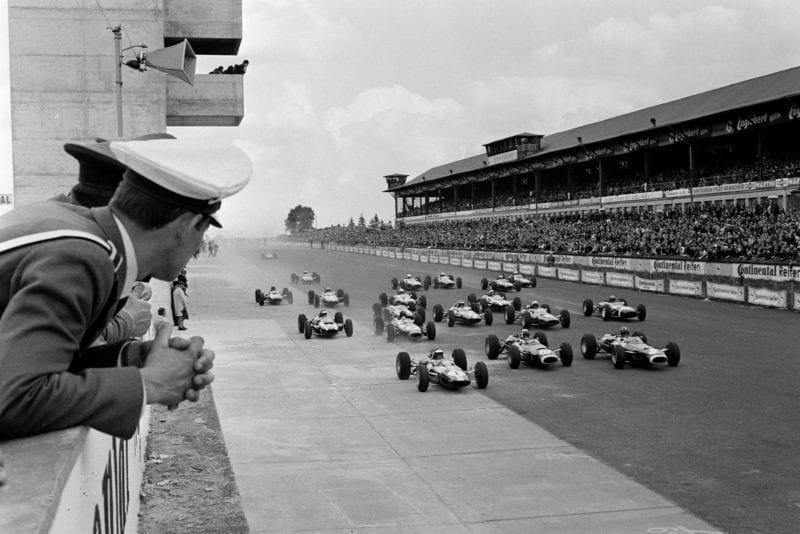
Clark gets the jump at the start
Motorsport Images
While the cars were being assembled on the grid there was a very small shower of rain, just to get everyone worried, but it did not develop nor did it wet the track. The front now of the grid comprised Clark with the Lotus and 32-valve Coventry-Climax engine, the two works BRMs of Stewart and Hill, and Surtees with what was basically the latest 12-cylinder Ferrari, chassis 0008.
Anderson had gone home to sort out his bent Brabham and Businello and Raby were non-starters due to not having gone fast enough in practice. The 19 starters moved forward from the “dummy-grid” and made a perfect start, Clark taking to the concrete or the pit area to gain more traction while the rest of the front row were on tarmac.
Halfway along the pit length Clark had a lead of a few yards and this enabled him to get into the South turn first, and then he was away. In the midst of all this Surtees was accelerating hard and changing up through the gears when the gear-selectors went wrong and he almost came to a standstill, so that everyone went past him.
Up the straight behind the pits, leading to the North curve and the descent down through the twists and turns towards Adenau, Clark was in front, followed by Hill, Gurney and Stewart but Surtees trailed slowly along at the back, with no high gears and forced to drive a whole lap before he could get assistance from his mechanics.
“Clark set up a new lap record and had a comfortable three seconds lead over Graham Hill, who was working hard to keep the Lotus in sight”
German television had some 17 cameras around the course and with a television set in the Brabham pit the progress of the leader could be followed and Colin Chapman was timing the gap between Clark and Hill at various points around the long circuit.
On his standing lap Clark set up a new lap record; with a time of 8min 36.1sec and had a comfortable three seconds lead over Graham Hill, who was working hard to keep the Lotus in sight. Stewart and Gurney were close behind and then there was a gap before Bandini and Spence arrived.
Surtees eventually arrived and stopped at the pits to have the gear-selectors attended to and Attwood also came into the pits, the BRM engine in his Lotus running erratically. It was found that the pick-up wires from the flywheel contacts for the ignition system were on the wrong way round and he went away sounding much healthier. Gardner never appeared at all, the step-up gears in his Hewland gearbox breaking on the opening lap.

Hill leads the battle between himself, Stewart and Gurney
Motorsport Images
On the second lap Clark went round in 8min 27.7sec, another new record, and Hill was still keeping him in sight, but Gurney was now third and some way back. Stewart had run onto the grass at Wippermann ess-bend and struck a solid object and bent the left-hand top front rockerarm suspension member as well as gathering a lot of grass and earth along the side of the car and on the back suspension. He drove back to the pits but there was no question of continuing and the car was wheeled away and all hopes for another “Scottish Double” were gone.
Fighting now for fourth place were a whole gaggle of drivers, nose to tail, side by side, and three abreast at times. They were Bandini (Ferrari), McLaren (Cooper), Spence (Lotus), Rindt (Cooper), Siffert (Brabham), Bonnier (Brabham), Brabham (Brabham) and Hulme (Brabham), with Mitter (Lotus) just behind them. Amon was stopped out on the circuit with electrical trouble and very soon after Hawkins joined him with a bad oil leak from the distributor drive seal on his Climax engine. As Amon suspected that his transistor box had given up he set about borrowing the one off Hawkins’ car.
Graham Hill was keeping up with Clark magnificently, and on the third lap they jointly set a new lap record in 8min 27.4sec and during this time Surtees rejoined the race with all his five gears, to appreciative and sympathetic applause from the large crowd. Gurney was a steady third and Spence was just in fourth place for he had a howling mob snapping at his rear wheels and in this bunch Rindt and Bandini were doing some pretty dicey pushing and shoving.
While Clark could keep up the terrific pressure, Graham Hill began to weaken slightly and after four laps Clark had a six-second lead, and the two of them had left Gurney well behind. The dice for fourth place broke up a bit when Bandini got into a full-lock slide and Rindt bumped the Ferrari and helped it on its way to a full spin, which dropped Bandini way back behind Mitten.
About this time Amon reappeared after a long absence and stopped at his pit to tell them what he had been doing, before setting off on another lap. During the fifth lap Hulme suddenly found his Brabham was handling in a peculiar fashion and dropped out of the fight for fourth place and called at his pit to have the steering looked at. There did not seem to be anything wrong and then he noticed petrol leaking from the righthand pannier tank.
Over the bumps and twists of the Nürburgring the seat had slid forward and rubbed a hole in the aluminium tank. This meant the end of Hulme’s race and he realised that the funny handling was probably due to the leaking petrol getting on his rear tyres. By now Clark had nine seconds’ lead over Graham Hill and Gurney was another 11 seconds further back, but Spence was still warding off the attacks of McLaren, Bonnier, Siffert and Rindt, though Brabham had dropped back a bit and was just ahead of Mitter.
There were only three other cars left in the race, these being Bandini’s Ferrari, Gregory’s BRM and Surtees in the 12-cylinder Ferrari being two and a half laps behind, with no hope of getting anywhere. Clark’s lead over Hill kept on getting bigger by about three seconds a lap and he was obviously driving a smooth and unhurried race, complete master of the Nürburgring and all his rivals.
On lap seven, which was nearly half-distance, the dice for fourth place had another upset, for McLaren was in trouble with his gear lever linkage and Bonnier suddenly went sideways on a fast downhill section and frightened himself. McLaren came into the pits to retire and Bonnier came in to make sure nothing, had come adrift on his Brabham, for he shouldn’t have got sideways-on at that part of the circuit. There was nothing obviously wrong so he rejoined the race, but he was now right out of the running. On the following lap Spence came to rest out on the circuit with a broken rubber coupling on a drive shaft and this let Siffert into fourth place, followed by Rindt and Brabham.
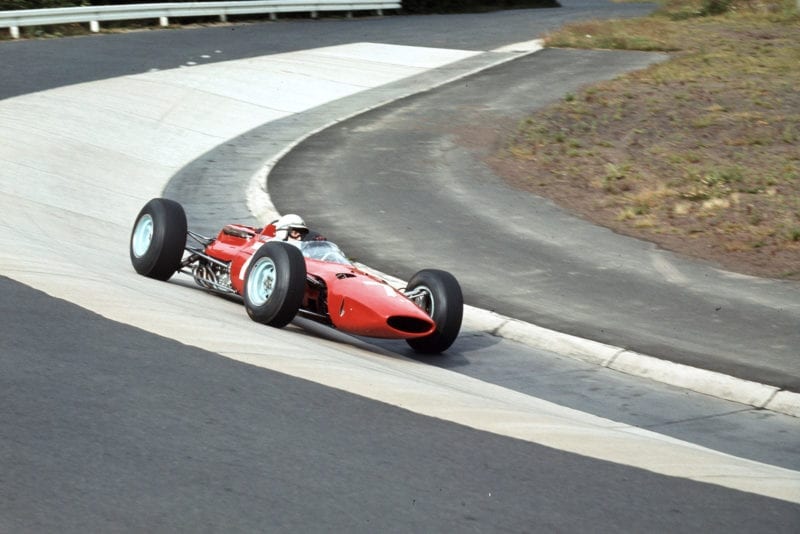
Surtees had to retire with gearbox issues
Motorsport Images
Then there was a moment of worry in the Lotus pit, for Mitter stopped in a cloud of steam, due to a Jubilee clip on a water pipe under the Lotus having been scraping on the ground in some of the clips on the circuit until it wore right through and let the rubber pipe come off. Attwood stopped for the same reason and it was wondered whether Clark’s car was bottoming that badly when the suspension was compressed by “G” forces.
As if to give assurance that all was well Clark did his tenth lap in 8min 24.1sec, an all-time record, and a speed of 162.9kph (over 101mph) and was now some 25 seconds ahead of Hill. Surtees had been lapping around 8min 28sec and when he came by, his pit indicated to him that Clark had set a record some four seconds quicker, in the hope that he’d try and do something about it. He did an 8min 27sec and then came in and retired as the gearbox was showing signs of going wrong again, so that was the end of the World Champion’s rather abortive race.
The unfortunate Siffert had blown up his BRM engine when his gearbox jumped out of gear over a hump, which lost him a certain fourth place, and it let Rindt up into the position with the second of the works Coopers. The field was now very thin, with only eight cars left running, for Amon had finally stopped out at the Karussel, after borrowing a second transistor box from Spence’s abandoned Lotus, but there was obviously something seriously wrong in the electrics that was causing the transistors to burn out. Clark lapped Masten Gregory on the 12th lap and could now take things easy, as he could keep an eye on Hill’s BRM as they passed in opposite directions on the way to and from the South Curve.
However, Hill was not having an easy time as Gurney had been gradually creeping up on him during the second ballot the race, but he was not catching up quickly enough to pass Hill, but it meant that the BRM driver could not relax. As they started their 15th and final round Clark had 23 seconds lead and the Climax engine sounded very healthy, and Hill had only nine seconds over Gurney, which the American whittled down to five and a half by the time they got the chequered flag. Clark came home to win his first German Grand Prix and to win his first Nürburgring race in typical Clark fashion, leading from start to finish.
“Out of six Grand Prix races entered this year by Clark and Lotus, they have won all six, which must make Jim Clark undisputed champion”
A long way back came Rindt and Brabham, then Bandini, who never made up any ground after his spin, then Bonnier, who was kicking himself for having thrown away fourth place, and finally Gregory. During the last lap the right-hand exhaust megaphone broke off Clark’s car, but apart from that he had had a remarkably trouble-free run, everything having worked perfectly.
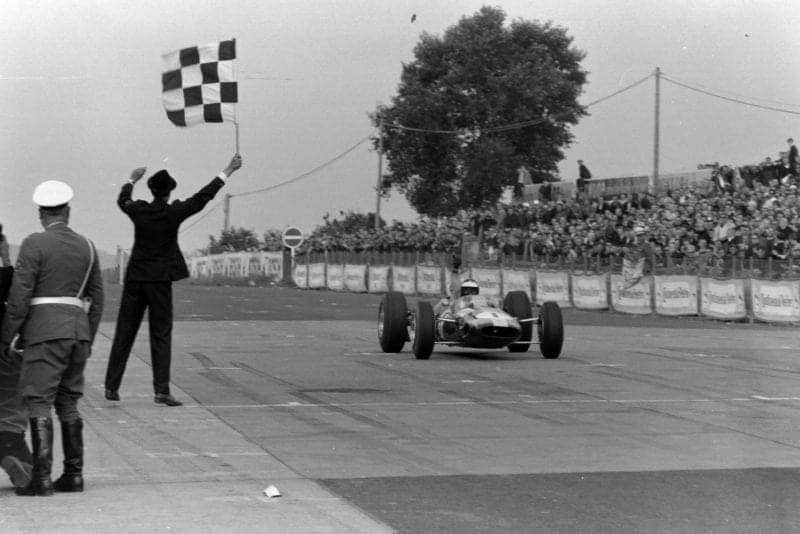
Clark takes the chequered flag
Motorsport Images
Out of six World Championship Grand Prix races entered this year, by Clark and Team Lotus, they have won all six, which must make Jim Clark undisputed Grand Prix champion driver and Lotus and Coventry-Climax undisputed Champion manufacturers of Grand Prix cars and engines.
